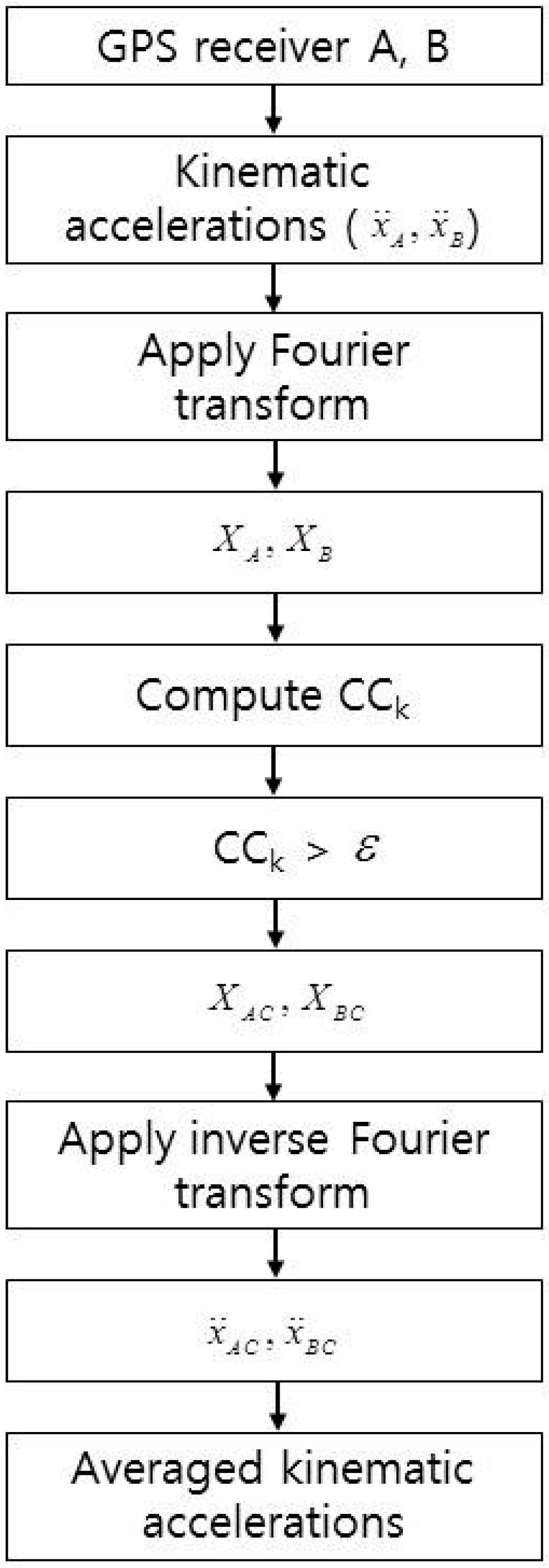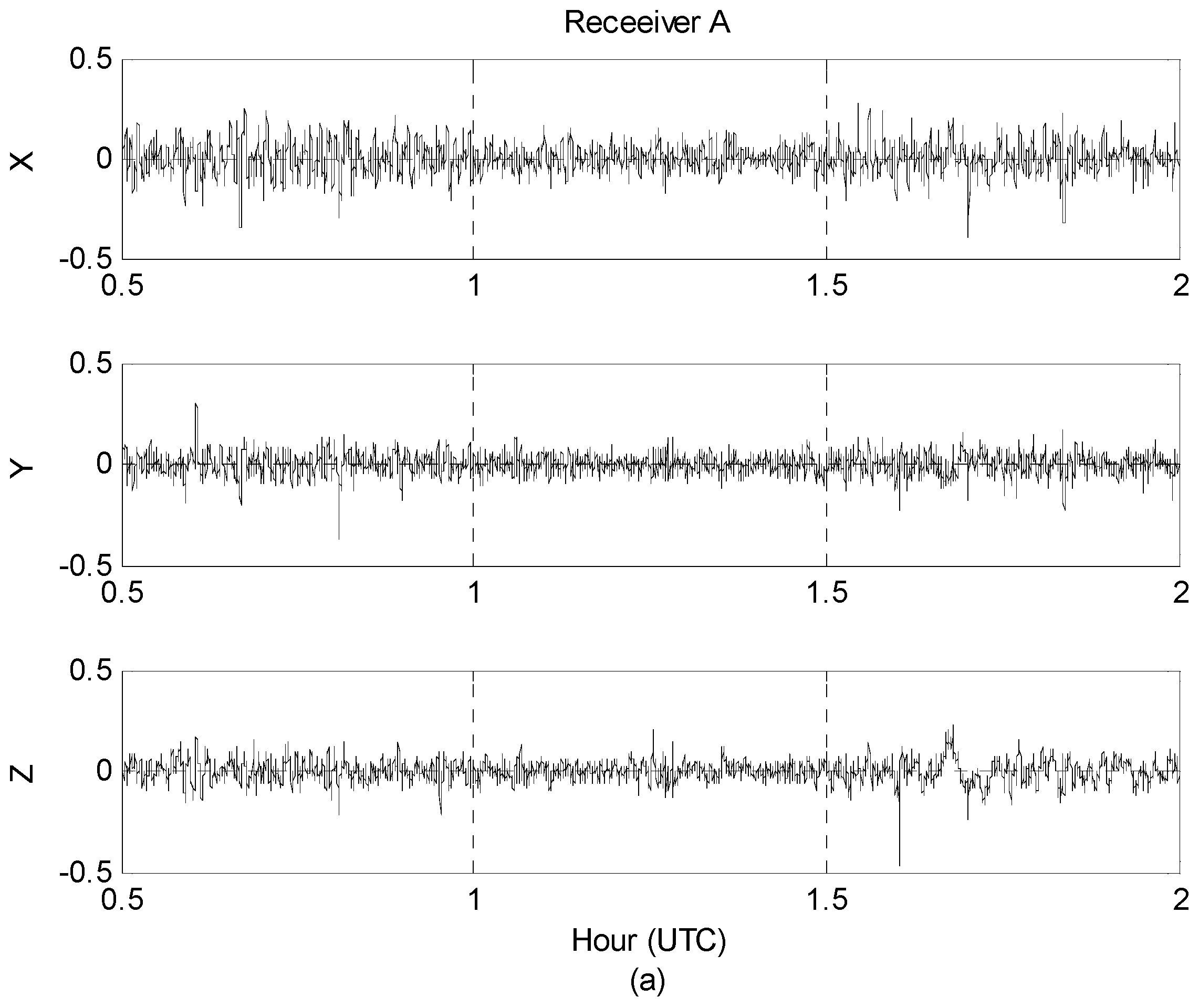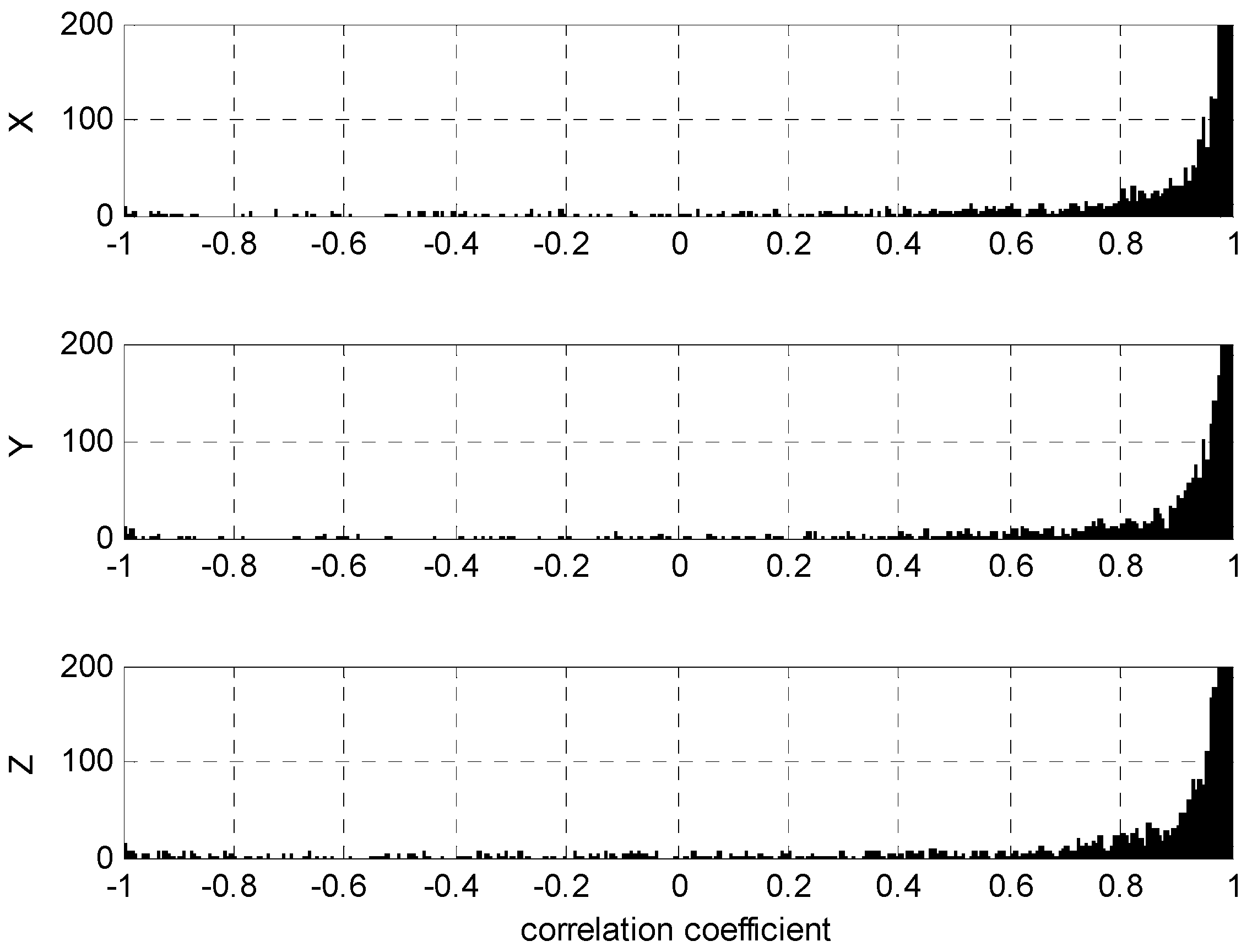1. Introduction
Global Positioning System (GPS) has been widely used in the fields which require accurate positioning in 3-D space. Nowadays, however, the GPS is also used in various non-positioning applications such as GPS meteorology and geodesy [
1,
2,
3]. One of the GPS applications in geodesy provides kinematic accelerations for airborne gravity surveying. The measured kinematic accelerations of the aircraft
are related to the earth’s gravitational acceleration
and other accelerations
according to the well-known navigation equation [
4] given by
By Equation (1), the accuracy of the gravity depends directly on the accuracy of the measured kinematic accelerations. The kinematic accelerations, in turn, are usually computed by taking second-order time-derivatives of the aircraft’s positions measured in relative positioning mode using single or multiple GPS stations [
5]. The kinematic accelerations can be estimated directly using the position-velocity-acceleration (PVA) model [
6,
7], which does not require taking the additional time-derivatives of the positions. However, both methods basically acquire precise kinematic acceleration information using relative GPS positioning that involves multiple receivers with a single antenna installed on the aircraft. Moreover, the multiple GPS receivers facilitate separating the meaningful signals from the receiver’s errors because the receivers share the single antenna’s signals.
In general, the gravity-based kinematic accelerations from multiple receivers should exhibit high positively correlated signals, whereas the minimally or negatively correlated signals reflect measurement noise in the kinematic accelerations. Thus, to separate the highly correlated signals from the noise components, the wavenumber correlation filter (WCF) can be applied, which computes correlation coefficients (CCs) between the signal’s frequency components according to the cosines of their phase differences. This method has been successfully applied to the geophysical and geodetic data obtained from the repeated survey tracks to significantly improve their signal-to-noise properties [
5,
8,
9,
10,
11,
12] approximated by
In this paper, airborne kinematic accelerations are enhanced using the WCF. The signal-to-noise results show significant accuracy improvement and can be obtained by suppressing the minimally and negatively correlated wavenumber components.
2. Methodology
Figure 1 shows the overall methodology adopted in this study. GPS receivers A and B installed on an aircraft simultaneously collect GPS measurements. The kinematic accelerations of the aircraft are computed using a network-based kinematic positioning technique with the PVA model which avoids numerical differentiation of the positions to obtain kinematic accelerations. The PVA model includes only the positions, but also the velocities and kinematic accelerations, of the aircraft in the Kalman filter’s state. Also, the corresponding transition matrix, which describes the dynamic of aircraft and GPS measurement model, is constructed for medium- to long-range kinematic applications. More details on the PVA model and the approaches adopted in this study can be found in [
6].
To apply WCF, the Fourier transforms are taken of the estimated kinematic accelerations from both receivers. The kinematic accelerations are next analyzed for their
k-th wavenumber correlation coefficients
using
where the numerator is the dot product of the
k-th Fourier transform wavevectors of the kinematic accelerations for receiver
and
, and the denominator is the cross-power of the wavevectors [
8,
9].
The CC for each frequency component from both datasets can be computed and compared with the predefined correlation tolerance . If the computed CC is larger than the tolerance, then that frequency component is passed as signal. Otherwise, it is assumed to be noise and rejected. In this study, the correlation tolerance was set to 0.9 because very high correlations are expected. Next, the WCF kinematic accelerations are recovered by inversely transforming the wavenumber components that exceed the preset correlation tolerance. Finally, the kinematic accelerations are least squares estimated by averaging the WCF kinematic accelerations. Evaluations of signal improvement are performed using the root-mean-squared (RMS) differences in the unfiltered and filtered receiver accelerations and their related signal-to-noise properties (Equation (2)).
3. Numerical Results
In 2009, the National Geographic Information Institute (NGII) of South Korea conducted airborne gravity surveying for a new geoid model of the Korean peninsula and surrounding marine areas. The survey was flown by Cessna Grand Caravan at speeds of about 280 km/h and a constant altitude of 10,000 feet. GPS data were collected from both GPS receivers and six ground-based continuously operating reference stations (CORS) at an interval of 1 s. GPS measurements were collected using both receivers connected to a single antenna with the kinematic accelerations of the aircraft being computed using the network-based PVA model proposed by [
6].
Figure 2 shows the 1.5 h span (~400 km in distance) of 1 htz GPS data collected on 11 January 2009 that were selected for this study.
Figure 3 presents the root-mean-squared (RMS) data differences between the two receivers with the statistical characteristics that are listed in
Table 1.
The power spectra for the receiver A- and B-measured kinematic accelerations are compared in
Figure 4 with similarly dominant patterns of the lower frequency components.
The CCs for all wavenumber components pairs were computed by Equation (3) as presented in
Figure 5, where relatively high positive correlations are dominant as also reinforced by the histograms of
Figure 6. These results suggest that the most robust cutoff or tolerance for constructing the WCF is
> 0 because negative CCs clearly reflect noise between the two receiver signals from a common antenna. However, the strong gradient change of histograms in
Figure 6 indicates that
0.8 or 0.9 may be even more discriminating of the antenna’s signal in both receivers.
Using the tolerance
0.9, for example, yields the wavenumber correlation filtered kinematic accelerations presented in
Figure 7.
Figure 8 gives the least squares kinematic acceleration estimates from the 2-point averages of the WCF data in
Figure 7 with the RMS errors shown in
Figure 9.
Table 2 lists the statistical mean and standard deviation values of the RMS errors along with correlation coefficients and affiliated noise percentages for the WCF kinematic accelerations of
Figure 7.
The
Table 1 minus
Table 2 differences in mean RMS errors yield reductions of 0.008122 m/s
2 (812 mGal), 0.0011657 m/s
2 (116.6 mGal), and 0.0003725 m/s
2 (37.3 mGal) in the respective X, Y, and Z components. Comparing the noise estimates in the tables also suggests that WCF obtained noise suppression improvements in the X, Y, and Z components of roughly 27%, 27%, and 20%, respectively.
It should be noted, however, that the WCF reduction of noise is but one contributor in the overall error propagation equation of the gravity signal’s estimation. Additional contributions include the effects of the data smoother, end matching of the flight lines, and the coordinate transformation [
5]. However, preliminary processing of the raw- and WCF-data with B-splines over 60 s smoothing windows resulted in gravity anomaly estimates with RMS error improvements in mGal of 31.0, 7.1, and 4.7 in the X, Y, and Z components, respectively. These results clearly represent significant improvements in gravity anomaly estimation for the subsurface exploration of the Earth e.g., [
13].















